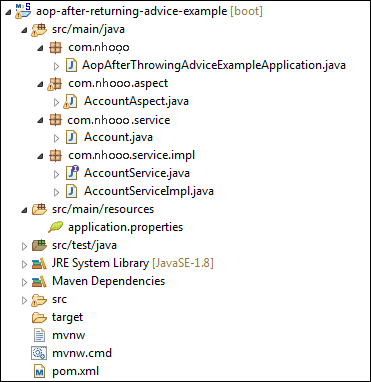SpringBoot 教程
- SpringBoot 教程
- SpringBoot 介绍
- Springboot Initializr
- Springboot 下载安装
- SpringBoot 项目创建
- SpringBoot 注解
- SpringBoot 依赖管理
- SpringBoot 应用程序属性
- SpringBoot Starters
- SpringBoot DevTools
- SpringBoot 多模块项目
- SpringBoot 打包
- SpringBoot 自动装配
- SpringBoot Tomcat部署
- SpringBoot AOP
- Spring Boot JPA
- SpringBoot Thymeleaf
- Spring Boot缓存
- SpringBoot 程序运行
- SpringBoot 更改端口
- SpringBoot REST示例
SpringBoot AOP @AfterThrowing
After throwing是Spring AOP中的建议类型。如果方法抛出异常,它将确保建议运行。我们使用 @AfterThrowing 注解来实现掷后建议。
语法:
@AfterThrowing(PointCut="execution(expression) ", throwing="name")
其中:
PointCut: 选择一个函数。
execution(expression):
throwing: 要返回的异常的名称。
让我们在应用程序中实现after-throwing建议。
Spring Boot @AfterThrowing示例
我们将在本节中使用前面的示例。您可以下载项目或在上一个示例中进行一些修改。
步骤1: 打开Spring Initializr http://start.spring.io 。
第2步: 提供 组名称。我们提供了组名 com.nhooo。
步骤3: 提供了 Artifact Id。提供Artifact Id aop-after-throwing-advice-example.。
步骤4: 添加 Spring Web 依赖项。
步骤5: 点击 生成按钮。当我们单击"生成"按钮时,它将所有规范包装在 jar 文件中,并将其下载到本地系统。
步骤6: 提取
第7步: 导入文件夹,请执行以下步骤:
File->Import- >现有Maven项目->下一步->浏览文件夹 aop-throwing-advice-example -> Finish。
步骤8: 打开 pom.xml 文件,并添加以下 AOP 依赖项。它是使用 Spring AOP 和 AspectJ 进行面向方面编程的入门。
<dependency> <groupId>org.springframework.boot</groupId> <artifactId>spring-boot-starter-aop</artifactId> </dependency> </dependencies>
pom.xml
<?xml version="1.0" encoding="UTF-8"?> <project xmlns="http://maven.apache.org/POM/4.0.0" xmlns:xsi="http://www.w3.org/2001/XMLSchema-instance" xsi:schemaLocation="http://maven.apache.org/POM/4.0.0 http://maven.apache.org/xsd/maven-4.0.0.xsd"> <modelVersion>4.0.0</modelVersion> <groupId>com.nhooo</groupId> <artifactId>aop-after-throwing-advice-example</artifactId> <version>0.0.1-SNAPSHOT</version> <packaging>jar</packaging> <name>aop-after-throwing-advice-example</name> <description>Demo project for Spring Boot</description> <parent> <groupId>org.springframework.boot</groupId> <artifactId>spring-boot-starter-parent</artifactId> <version>2.2.2.RELEASE</version> <relativePath/> <!-- lookup parent from repository --> </parent> <properties> <project.build.sourceEncoding>UTF-8</project.build.sourceEncoding> <project.reporting.outputEncoding>UTF-8</project.reporting.outputEncoding> <java.version>1.8</java.version> </properties> <dependencies> <dependency> <groupId>org.springframework.boot</groupId> <artifactId>spring-boot-starter-aop</artifactId> </dependency> <dependency> <groupId>org.springframework.boot</groupId> <artifactId>spring-boot-starter-test</artifactId> <scope>test</scope> </dependency> </dependencies> <build> <plugins> <plugin> <groupId>org.springframework.boot</groupId> <artifactId>spring-boot-maven-plugin</artifactId> </plugin> </plugins> </build> </project>
步骤9: 在 src/main/java 文件夹 中创建名称为 com.nhooo.model 的包。
步骤10: 在包 com.nhooo.model中创建一个名称为 Account 的类。
在"帐户"类中,执行以下操作:
定义了两个类型为String的变量 accountNumber 和 accountType 。 右键单击File -> Source->使用字段生成构造函数 生成Getters。
右键单击File-> Source-> Generate Getters和Setters->选择Getters-> Generate 生成 toString()
右键单击文件->源->生成toString()
Account.java
package com.nhooo.model;
public class Account
{
private String accountNumber;
private String accountType;
public Account(String accountNumber, String accountType)
{
super();
this.accountNumber = accountNumber;
this.accountType = accountType;
}
public String getAccountType()
{
return accountType;
}
public String getAccountNumber()
{
return accountNumber;
}
@Override
public String toString()
{
return "Account [accountNumber=" + accountNumber+ ", accountType=" + accountType + "]";
}
}
步骤11: 创建另一个名为 com.nhooo.service.impl的包。
步骤12: 在此程序包中,创建一个名称为 AccountServiceImple的类。
在该类中,我们定义了帐户服务。
AccountServiceImpl.Java
package com.nhooo.service.impl;
import java.util.HashMap;
import java.util.Map;
import java.util.Map.Entry;
import java.util.Set;
import org.springframework.stereotype.Service;
import com.nhooo.model.Account;
@Service
public class AccountServiceImpl implements AccountService
{
//storing account detail in the HashMap
private static Map<String,Account> map = null;
static
{
map = new HashMap<>();
//adding account detail in the map
map.put("M4546779", new Account("10441117000", "Saving Account"));
map.put("K2434567", new Account("10863554577", "Current Account"));
}
@Override
public Account getAccountByCustomerId(String customerId) throws Exception
{
if(customerId ==null)
{
throw new Exception("Invalid! Customer Id");
}
Account account= null;
Set<Entry<String, Account>> entrySet = map.entrySet();
for (Entry<String, Account> entry : entrySet)
{
if(entry.getKey().equals(customerId))
{
account= entry.getValue();
}
}
return account;
}
}
步骤13: 在包 com.nhooo.service.impl。 中创建一个名称为 AccountService 的接口。
AccountService.java
package com.nhooo.service.impl;
import com.nhooo.model.Account;
//creating interface that throws exception if the customer id not found
public interface AccountService
{
public abstract Account getAccountByCustomerId(String customerId)
throws Exception;
}
步骤14: 创建名称为 com.nhooo.aspect的包。
步骤15: 在包 com.nhooo.aspect 中创建一个名称为 AccountAspect 的类。
在该类中,我们通过使用以下方式实现了投掷后建议注解 @AfterThrowing。 我们还定义了 afterThrowingAdvice()方法。
AccountAspect.java
package com.nhooo.aspect;
import org.aspectj.lang.JoinPoint;
import org.aspectj.lang.annotation.AfterThrowing;
import org.aspectj.lang.annotation.Aspect;
import org.springframework.stereotype.Component;
@Aspect
@Component
public class AccountAspect
{
//implementing after throwing advice
@AfterThrowing(value="execution(* com.nhooo.service.impl.AccountServiceImpl.*(..))",throwing="ex")
public void afterThrowingAdvice(JoinPoint joinPoint, Exception ex)
{
System.out.println("After Throwing exception in method:"+joinPoint.getSignature());
System.out.println("Exception is:"+ex.getMessage());
}
}
步骤16: 打开 AopAfterThrowingAdviceExampleApplication.java 文件并添加注解 @EnableAspectJAutoProxy。
注解支持处理带有AspectJ的 @Aspect 批注的组件。它与@Configuration批注一起使用。
我们使用了@EnableAspectJAutoProxy批注的 proxyTargetClass 属性。属性 proxyTargetClass = true 允许我们使用 CGLIB (代码生成库)代理,而不是默认的基于接口的JDK代理方法。
ConfigurableApplicationContext 是一个接口,除了ApplicationContext中的应用程序上下文客户端方法外,还提供了用于配置应用程序上下文的工具。
AopAfterThrowingAdviceExampleApplication.java
package com.nhooo;
import org.springframework.boot.SpringApplication;
import org.springframework.boot.autoconfigure.SpringBootApplication;
import org.springframework.context.ConfigurableApplicationContext;
import org.springframework.context.annotation.EnableAspectJAutoProxy;
import com.nhooo.model.Account;
import com.nhooo.service.impl.AccountService;
import com.nhooo.service.impl.AccountServiceImpl;
@SpringBootApplication
//@EnableAspectJAutoProxy注解支持处理用@Aspect注解标记的组件。它类似于xml配置中的标记。
@EnableAspectJAutoProxy(proxyTargetClass=true)
public class AopAfterThrowingAdviceExampleApplication
{
public static void main(String[] args)
{
ConfigurableApplicationContext ac = SpringApplication.run(AopAfterThrowingAdviceExampleApplication.class, args);
//从应用程序上下文获取account对象
AccountService accountService = ac.getBean("accountServiceImpl", AccountServiceImpl.class);
Account account;
try
{
//生成异常
account = accountService.getAccountByCustomerId(null);
if(account != null)
System.out.println(account.getAccountNumber()+"\t"+account.getAccountType());
}
catch (Exception e)
{
System.out.println(e.getMessage());
e.printStackTrace();
}
}
}
创建所有类和包后,项目目录如下所示:

步骤17: 打开 AopAfterThrowingAdviceExampleApplication.java 文件并将其作为Java应用程序运行。它显示输出,如下所示:
